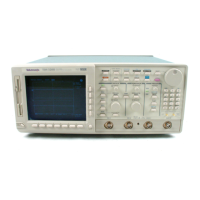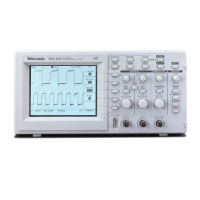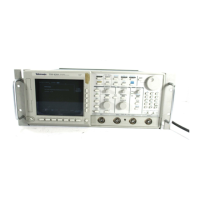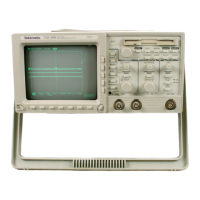Triggering on Waveforms
TDS 500D, TDS 600B, & TDS 700D User Manual
3–117
Level lets you enter the trigger level using the general purpose knob or the
keypad.
Set to TTL fixes the trigger level at +1.4 V.
Set to ECL fixes the trigger level at –1.3 V.
Set to 50% fixes the trigger level to approximately 50% of the peak-to-peak
value of the trigger source signal. When AMI is selected, this selection measures
the peak-to-peak level and sets the upper threshold to 75% and the lower
threshold to 25%. If you select a DS0 mask the trigger level is set correctly, do
not press the front panel button SET LEVEL TO 50%.
Delayed Triggering
The TDS Oscilloscope provides a main time base and a delayed time base. The
delayed time base, like the main time base, requires a trigger signal and an input
source dedicated to that signal. You can only use delay with respect to the main
edge trigger and certain classes of main pulse triggers. This section describes
how to delay the acquisition of waveforms.
There are two different ways to delay the acquisition of waveforms: delayed runs
after main and delayed triggerable. Only delayed triggerable uses the delayed
trigger system. Delayed runs after main looks for a main trigger, then waits a
user-defined time, and then starts acquiring. (See Figure 3–54.)
Wait User-specified
Time
Acquire
Data
Wait for
Main
Trigger
Figure 3–54: Delayed Runs After Main
Delayed triggerable looks for a main trigger and then, depending on the type of
delayed trigger selected, makes one of the three types of delayed triggerable mode
acquisitions: After Time, After Events, or After Events/Time. Study Figure 3–55 to
understand the sequence the oscilloscope goes through for each delayed mode.

